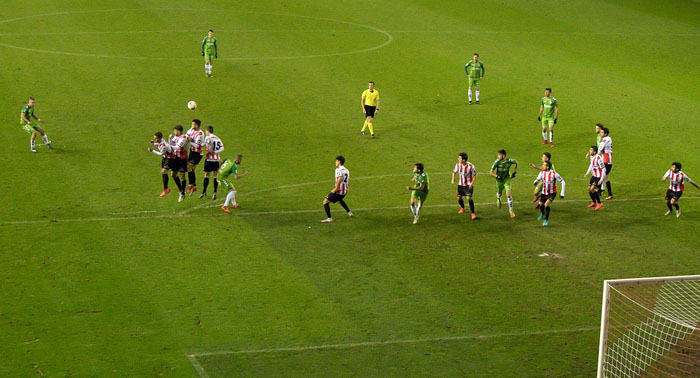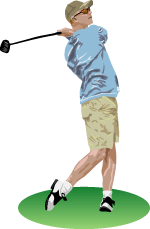Technology use in sports is increasing rapidly, though the sport of football/soccer was slow to incorporate some forms of technology that other sports have embraced. This article discusses the use of technology to determine if a ball has crossed the goal line, one way that technology can greatly assist in football. The use of video to help adjudicate fouls and offside and marking foam is also discussed.
VAR - Video Assistant Referee
FIFA first used video replays (Video Assistant Referee or VAR) at the World Cup in Russia in 2018 to assist with referee decisions. This followed successful trials over the preceding couple of years. There are four types of calls that can be reviewed: goals, penalty decisions, red card decisions, and mistaken identity in awarding a card. The video assistant referee reviews video replays of the event, and where there is a clear error can relay that information to the central referee via wireless radio to a headset worn by the referee.
In 2018, VAR was incorporated into the Laws of the Game by football's lawmakers, the International Football Association Board (IFAB).
Semi-Automated Offside Technology (SAOT)
Semi-automated offside technology was used for the first time in soccer history at the FIFA World Cup 2022 in Qatar, after successful trials at previous FIFA tournaments. This offside decision-making technology uses 12 cameras mounted around the field which track multiple data points on the ball and each individual player at 50 times per second, plus using a signal from a sensor in the ball, to calculate their exact position on the pitch to accurately determine in real time if offside has occurred. This data is provided to the video match officials, which can then notify this information to the central referee.
Soccer Goal Line Technology
There is a great need for goal-line technology in soccer, particularly as there are numerous examples where the TV reply has been able to show wrong decisions by the referee, where a ball has or has not passed over the goal line, and the goal was given or not given. Similar technology has been successfully implemented in cricket, tennis and American Football, and in general the fans have welcomed it.
Requirements
There are several options available for goal line technology. The International Football Association Board (IFAB) had an extensive trial period to ensure that they got it right before they implemented any system. For anyone who has seen their team robbed of a win because no such system is in place, it will not be implemented soon enough.
The following four criteria are desired for a successful goal-line system:
- The technology should only apply to goal-line decisions.
- The system must be 100 percent accurate.
- The signal sent to the referee must be instantaneous.
- The signal is only communicated to the match officials.
 a football player's attempt at goal
a football player's attempt at goalSeveral Possible Options
There were three main options that were looked at for soccer goal line technology. In 2013, FIFA granted a licence to third goal-line technology manufacturer, German firm Cairos, joining the Hawk-Eye and GoalRef systems for the rights for use at the 2014 World Cup and the 2013 Confederations Cup, both to be held in Brazil.
- Smart Ball system
A promising prospect has been a "smartball" loaded with a sensor suspended inside, jointly developed by German companies Cairos Technologies and Adidas athletic clothing and shoe company. The companies' technology uses a network of receivers around the field designed to track the ball's precise position in real time - including exactly when it has fully passed the goal line. That information would be relayed in less than a second to a watch-like device worn by the referee.
- Hawkeye system
The system by the UK company Hawk-Eye has had very successful trials and is the front runner out of the systems in development. Hawke-Eye has already been used to make calls in tennis and in cricket. The Football version has been extensively trailed and has performed very well in the test environment. The Hawke Eye system uses three cameras focused on each goal-line, and each taking footage at 600 frames a second. Hawk-Eye is able to give a definitive decision on whether the ball has fully crossed the line, and relay this information in the form of an audible beep to the central referee within half a second. As the Premier League referees use headsets, the signal is easily sent to them. In other leagues, other methods such as through a watch can be used.
- Goal Ref system
The Goal Ref goal detection system has been developed by the company Fraunhofer IIS. This system is a radio-based system, which uses low-frequency magnetic fields to determine whether or not the whole ball has passed over the goal line. There are two magnetic fields - one in the goal area (using coils attached to the goal), the other is created in and around the ball (using a passive electronic circuit embedded in the ball). The data is processed and then transmitted wirelessly to the referee’s wristwatch, and a message is displayed in real time, in addition to a vibrating alert.
The Beginning - 2013
A camera-based system (like Hawk-Eye) was found to be best. In 2013 FIFA announced that a camera-based system, GoalControl, would be used at the 2013 Confederations Cup. The trial was successful, and the GoalControl system was confirmed for the 2014 FIFA World Cup. GoalControl-4D uses 14 high-speed cameras located around the pitch and directed at both goals. In 2013 the English Football Association announced that Hawk-Eye would be used in the 2013-14 Premier League season.
Foam Technology
A spray of vanishing foam is another recent use of technology in football, which came to prominence at the 2014 Brazil World Cup. Its first use in international football was when it was trialled at the 2013 FIFA U-20 World Cup, 2013 FIFA U-17 World Cup and 2013 FIFA Club World Cup. The spray is a temporary foam applied by the referee to the field to provide a visual marker for use by both players and referees to indicate the minimum distance that members of the opposing team must remain from the ball during a free kick, as well as the spot from which the kick is taken.
The can contains about 80% water and 20% butane gas with a small about of surfactant. When released from the can, the butane expands due to pressure changes, forming small drops of butane covered with water. Eventually the butane evaporates, leaving only water and surfactant residue on the ground. The marks disappear after about one minute.
Related Pages
- Soccer poll: Should Soccer use a video referee?
- Soccer Physics
- Technology in Sports
- Hawke-Eye in Tennis.
- Football Equipment



